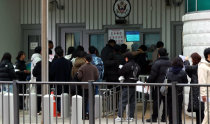Military Secrets
A contradiction has ensued between efforts to resolve suspicions over the sinking of the naval patrol ship Cheonan and military confidentiality. The military should provide a detailed explanation to answer lingering questions. In the process of dealing with the suspicions, however, certain materials related with military secrets could be released. Many of the rumors and suspicions surrounding the incident have been proven wrong, but should have been dealt more aggressively by the government and the military from the beginning. The Defense Ministry has refused to disclose military secrets. Yet certain confidential information including secrets on intelligence on gathering information on North Korea has been released, which could negatively affect national security.
A large portion of the suspicions over the Cheonan resulted from the militarys announcement of the time when the vessel began to sink. After changing the time several times, the military finally gave 9:22 p.m. March 26 as a final time. An MBC TV report on the time of the sinking fueled controversy. Bereaved relatives of missing sailors were quoted as saying their mobile phone communication was suddenly suspended around 9:16 p.m. MBC also said a naval log wrongly noted that the incident happened at 9:15 p.m. Other media even released speculative news stories with the headlines Seven Minutes Surrounded by Suspicion, What Happened to the Cheonan?, and Unanswered Questions over the Suspicious Seven Minutes. All of the rumors were proven wrong, however.
Four or five surviving crewmen of the Cheonan turned out to have talked on their mobile phones between 9:15 p.m. and 9:20 p.m. March 26, and this explains the different times given for the sinking. The theory that the Cheonan was wrecked on a rock was also proven wrong as naval investigators found no rocks in the area. Rumors of a fatigue fracture of the Cheonan were also disproven. Cheonan survivors are scheduled to make public statements today. The militarys decision to keep survivors from the media and their families for more than 10 days was wrong. Had they been allowed to tell the truth far earlier, their eyewitness accounts would have been a big help in quelling groundless suspicions.
Many military secrets have been disclosed in the process of resolving suspicions. Information released in the process includes the Navys military force and strategy, the structure of naval ships, financial resources, and capabilities and measures to detect North Koreas military movements. Defense Minister Kim Tae-young should not have released information on a North Korean submarine base collected by intelligence in Seoul and Washington and the migratory route of South Korean naval ships at the National Assembly.
The military should wisely deal with lawmakers who urge the release of defense secrets. For example, lawmakers should agree to not release sensitive information or get briefed on why it cannot be open knowledge. Kim Hak-song, the chairman of the parliamentary defense committee, also erred by releasing all kinds of military secrets to the media. Some have even asked for the release of the communications log between the headquarters of the 2nd Naval Fleet and the patrol ship Sokcho. If this is opened to the public, however, the South Korean militarys code system or military operations might be released to North Korea. Lawmakers should help the military keep confidential information secret. The media also needs to consider national security before rushing to report sensitive military data.







